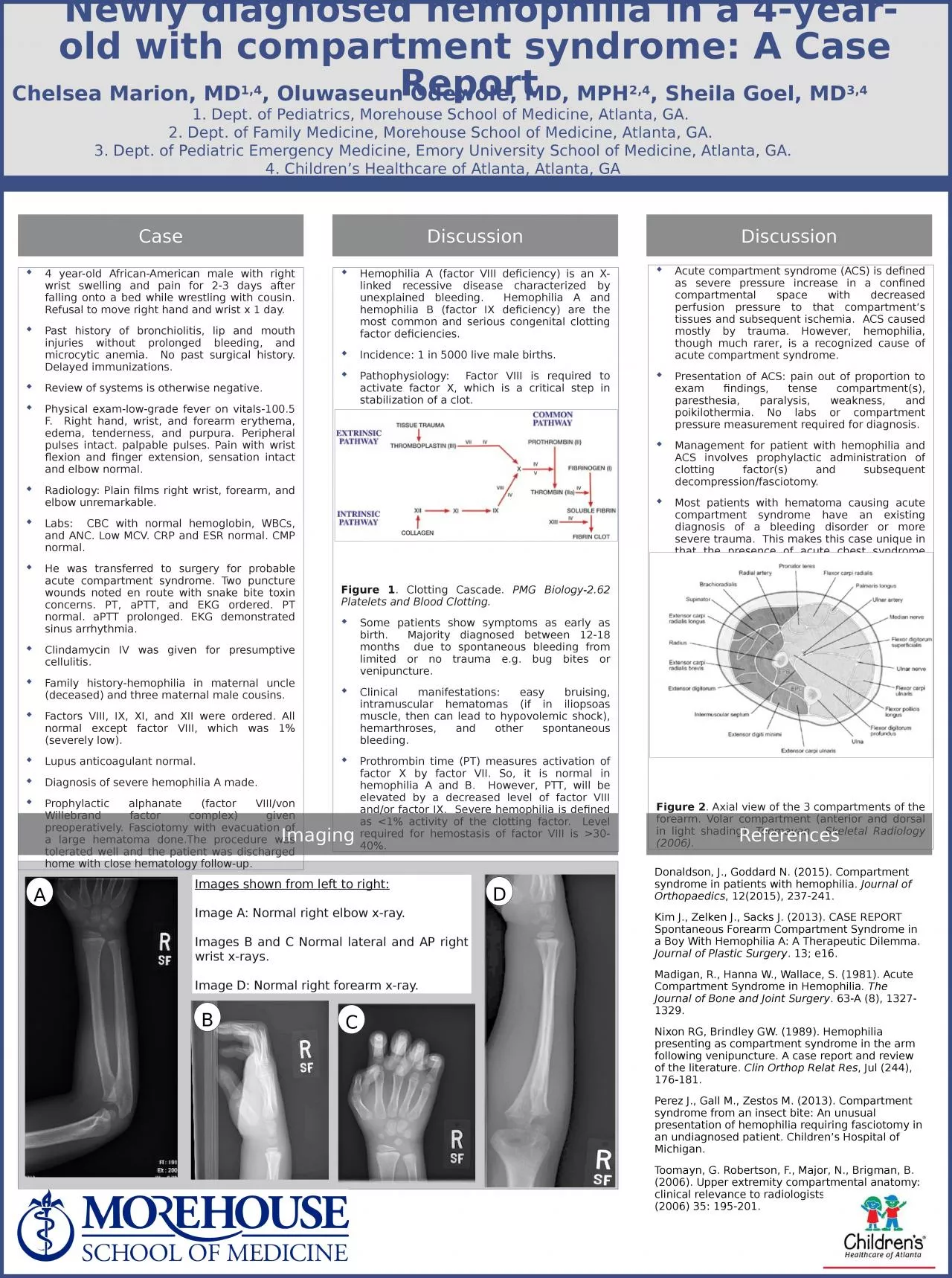

Chelsea Marion MD 14 Oluwaseun Odewole MD MPH 24 Sheila Goel MD 34 1 Dept of Pediatrics Morehouse School of Medicine Atlanta GA 2 Dept of Family Medicine Morehouse School of Medicine Atlanta GA ID: 1000576
Download Presentation The PPT/PDF document "Newly diagnosed hemophilia in a 4-year-o..." is the property of its rightful owner. Permission is granted to download and print the materials on this web site for personal, non-commercial use only, and to display it on your personal computer provided you do not modify the materials and that you retain all copyright notices contained in the materials. By downloading content from our website, you accept the terms of this agreement.
1. Newly diagnosed hemophilia in a 4-year-old with compartment syndrome: A Case Report Chelsea Marion, MD1,4, Oluwaseun Odewole, MD, MPH2,4, Sheila Goel, MD3,4 1. Dept. of Pediatrics, Morehouse School of Medicine, Atlanta, GA. 2. Dept. of Family Medicine, Morehouse School of Medicine, Atlanta, GA. 3. Dept. of Pediatric Emergency Medicine, Emory University School of Medicine, Atlanta, GA.4. Children’s Healthcare of Atlanta, Atlanta, GA4 year-old African-American male with right wrist swelling and pain for 2-3 days after falling onto a bed while wrestling with cousin. Refusal to move right hand and wrist x 1 day.Past history of bronchiolitis, lip and mouth injuries without prolonged bleeding, and microcytic anemia. No past surgical history. Delayed immunizations.Review of systems is otherwise negative.Physical exam-low-grade fever on vitals-100.5 F. Right hand, wrist, and forearm erythema, edema, tenderness, and purpura. Peripheral pulses intact. palpable pulses. Pain with wrist flexion and finger extension, sensation intact and elbow normal.Radiology: Plain films right wrist, forearm, and elbow unremarkable.Labs: CBC with normal hemoglobin, WBCs, and ANC. Low MCV. CRP and ESR normal. CMP normal.He was transferred to surgery for probable acute compartment syndrome. Two puncture wounds noted en route with snake bite toxin concerns. PT, aPTT, and EKG ordered. PT normal. aPTT prolonged. EKG demonstrated sinus arrhythmia. Clindamycin IV was given for presumptive cellulitis.Family history-hemophilia in maternal uncle (deceased) and three maternal male cousins.Factors VIII, IX, XI, and XII were ordered. All normal except factor VIII, which was 1% (severely low). Lupus anticoagulant normal.Diagnosis of severe hemophilia A made.Prophylactic alphanate (factor VIII/von Willebrand factor complex) given preoperatively. Fasciotomy with evacuation of a large hematoma done.The procedure was tolerated well and the patient was discharged home with close hematology follow-up.Hemophilia A (factor VIII deficiency) is an X-linked recessive disease characterized by unexplained bleeding. Hemophilia A and hemophilia B (factor IX deficiency) are the most common and serious congenital clotting factor deficiencies.Incidence: 1 in 5000 live male births.Pathophysiology: Factor VIII is required to activate factor X, which is a critical step in stabilization of a clot.Figure 1. Clotting Cascade. PMG Biology-2.62 Platelets and Blood Clotting.Some patients show symptoms as early as birth. Majority diagnosed between 12-18 months due to spontaneous bleeding from limited or no trauma e.g. bug bites or venipuncture.Clinical manifestations: easy bruising, intramuscular hematomas (if in iliopsoas muscle, then can lead to hypovolemic shock), hemarthroses, and other spontaneous bleeding.Prothrombin time (PT) measures activation of factor X by factor VII. So, it is normal in hemophilia A and B. However, PTT, will be elevated by a decreased level of factor VIII and/or factor IX. Severe hemophilia is defined as <1% activity of the clotting factor. Level required for hemostasis of factor VIII is >30-40%.Acute compartment syndrome (ACS) is defined as severe pressure increase in a confined compartmental space with decreased perfusion pressure to that compartment’s tissues and subsequent ischemia. ACS caused mostly by trauma. However, hemophilia, though much rarer, is a recognized cause of acute compartment syndrome.Presentation of ACS: pain out of proportion to exam findings, tense compartment(s), paresthesia, paralysis, weakness, and poikilothermia. No labs or compartment pressure measurement required for diagnosis.Management for patient with hemophilia and ACS involves prophylactic administration of clotting factor(s) and subsequent decompression/fasciotomy.Most patients with hematoma causing acute compartment syndrome have an existing diagnosis of a bleeding disorder or more severe trauma. This makes this case unique in that the presence of acute chest syndrome from a limited trauma is what led to the diagnosis of severe hemophilia in this patient.Figure 2. Axial view of the 3 compartments of the forearm. Volar compartment (anterior and dorsal in light shading). Toomayan, Skeletal Radiology (2006).DiscussionDiscussionCaseDonaldson, J., Goddard N. (2015). Compartment syndrome in patients with hemophilia. Journal of Orthopaedics, 12(2015), 237-241. Kim J., Zelken J., Sacks J. (2013). CASE REPORT Spontaneous Forearm Compartment Syndrome in a Boy With Hemophilia A: A Therapeutic Dilemma. Journal of Plastic Surgery. 13; e16. Madigan, R., Hanna W., Wallace, S. (1981). Acute Compartment Syndrome in Hemophilia. The Journal of Bone and Joint Surgery. 63-A (8), 1327-1329. Nixon RG, Brindley GW. (1989). Hemophilia presenting as compartment syndrome in the arm following venipuncture. A case report and review of the literature. Clin Orthop Relat Res, Jul (244), 176-181. Perez J., Gall M., Zestos M. (2013). Compartment syndrome from an insect bite: An unusual presentation of hemophilia requiring fasciotomy in an undiagnosed patient. Children’s Hospital of Michigan. Toomayn, G. Robertson, F., Major, N., Brigman, B. (2006). Upper extremity compartmental anatomy: clinical relevance to radiologists. Skeletal Radiol. (2006) 35: 195-201.ReferencesImagingImages shown from left to right:Image A: Normal right elbow x-ray.Images B and C Normal lateral and AP right wrist x-rays.Image D: Normal right forearm x-ray.ABCD